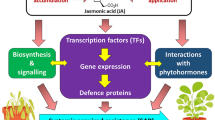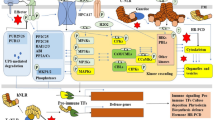Abstract
The founder of the MiAMP1 protein family was originally isolated from Macadamia integrifolia and had antimicrobial activity in vitro. MiAMP1 was the first plant protein with a structure containing a βγ-crystallin precursor fold, a structural superfamily associated with antimicrobial proteins in other kingdoms. In recent times, expanding plant genomics information has revealed that genes encoding homologues of MiAMP1 are conserved across the plant kingdom from lycophytes, gymnosperms to early angiosperms (e.g. Amborella, Papaver) and some monocots (e.g. Zantedeschia, Zea, Sorghum). Many studies of plant–pathogen interactions in gymnosperms have demonstrated a potential role for MiAMP1 family members in defence against fungal pathogens. This commentary describes the discovery and diversity of this protein family and considers current evidence supporting, and future opportunities for substantiating, a role in defence in primitive plants, and why this role may have diminished in higher plants.


Similar content being viewed by others
References
Adomas A, Asiegbu FO (2006) Analysis of organ-specific responses of Pinus sylvestris to shoot (Gremmeniella abietina) and root (Heterobasidion annosum) pathogens. Physiol Mol Plant Pathol 69:140–52. doi:10.1016/j.pmpp.2007.04.001
Adomas A, Heller G, Li G, Olson A, Chu TM, Osborne J, Craig D, van Zyl L, Wolfinger R, Sederoff R, Dean RA, Stenlid J, Finlay R, Asiegbu FO (2007) Transcript profiling of a conifer pathosystem: responses of Pinus sylvestris root tissues to pathogen (Heterobasidion annosum) invasion. Tree Physiol 27:1441–1458
Antuch W, Guntert P, Wuthrich K (1996) Ancestral βγ-crystallin precursor structure in a yeast killer toxin. Nat Struct Biol 3:662–665. doi:10.1038/nsb0896-662
Asiegbu FO, Choi W, Li W, Nahalkova J, Dean RA (2003) Isolation of a novel antimicrobial peptide gene (Sp-AMP) homologue from Pinus sylvestris (Scots pine) following infection with the root rot fungus Heterobasidion annosum. FEMS Microbiol Lett 228:27–31. doi:10.1016/S0378-1097(03)00697-9
Asiegbu FO, Nahalkova J, Li G (2005) Pathogen-inducible cDNAs from the interaction of the root rot fungus Heterobasidion annosum with Scots pine (Pinus sylvestris L.). Plant Sci 168:365–372. doi:10.1016/j.plantsci.2004.08.010
Brown RL, Kazan K, McGrath K, Maclean DJ, Manners JM (2003) A role for the GCC box in jasmonate-mediated activation of the PDF1.2 gene of Arabidopsis. Plant Physiol 132:1020–1032. doi:10.1104/pp.102.017814
Campos Olivas R, Horr I, Bormann C, Jung G, Gronenborn AM (2001) Solution structure, backbone dynamics and chitin binding of the anti-fungal protein from Streptomyces tendae TU901. J Mol Biol 308:765–782. doi:10.1006/jmbi.2001.4622
Davidson J, Ekramoddoullah AKM (1997) Analysis of bark proteins in blister rust-resistant and susceptible western white pine (Pinus monticola). Tree Physiol 17:663–669
Ekramoddoullah AKM (2005) Molecular tools in the study of the white pine blister rust [Cronartium ribicola] pathosystem. Can J Plant Pathol 27:510–520
Ekramoddoullah AKM, Liu JJ, Zamani A (2006) Cloning and characterisation of a putative antifungal peptide gene (Pm-AMP1) in Pinus monticola. Phytopathol 96:164–170
Elfstrand M, Fossdal CG, Swedjemark G, Clapham D, Olsson O, Sitbon F, Sharma P, Lonneborg A, von Arnold S (2001) Identification of candidate genes for use in molecular breeding—a case study with the Norway spruce defensin-like gene, Spi1. Silvae Genet 50:75–81
Ferreira RB, Moneiro S, Freitas R, Santos CN, Chen Z, Batista LM, Duarte J, Borges A, Teixeira AR (2007) The role of plant defence proteins in fungal pathogenesis. Mol Plant Pathol 8:677–700. doi:10.1111/j.1364-3703.2007.00419.x
Hammerschmidt R (2006) Host-pathogen interaction in conifers: complicated systems yield interesting possibilities for research. Physiol Mol Plant Pathol 68:93–94. doi:10.1016/j.pmpp.2007.01.002
Harrison MJ (2005) Signalling in the arbuscular mycorrhizal association. Annu Rev Microbiol 59:19–42. doi:10.1146/annurev.micro.58.030603.123749
Harrison SJ, Marcus JP, Goulter K, Green JL, Maclean DJ, Manners JM (1997) An antimicrobial peptide from the Australian native Hardenbergia violacea provides the first functionally characterised member of a subfamily of plant defensins. Aust J Plant Physiol 24:571–578
Heller G, Adomas A, Li G, Osborne J, van Zyl L, Sederoff R, Finlay RD, Stenlid J, Asiegbu FO (2008) Transcriptional analysis of Pinus sylvestris roots challenged with the ectomycorrhizal fungus Laccaria bicolour. BMC Plant Biol 8:19. doi:10.1186/1471-2229-8-19
Jansen RK, Cai Z, Raubeson LA, Daniell H, dePamphilis CW, Leebens-Mack J, Muller KF, Guisinger-Bellian M, Haberle RC, Hansen AK, Chumley TW, Lee SB, Peery R, McNeal JR, Kuehl JV, Boore JL (2007) Analysis of 81 genes from 64 plastid genomes resolves relationships in angiosperms and identifies genome scale evolutionary patterns. Proc Natl Acad Sci USA 104:19369–19374. doi:10.1073/pnas.0709121104
Kazan K, Manners JM (2008) Jasmonate signalling: towards an integrated view. Plant Physiol 146:1459–1468. doi:10.1104/pp.107.115717
Kazan K, Rusu AG, Marcus JP, Goulter KC, Manners JM (2002) Enhanced quantitative resistance to Leptosphaeria maculans conferred by expression of a novel antimicrobial peptide in canola (Brassica napus L.). Mol Breed 10:63–70. doi:10.1023/A:1020354809737
Li G, Asiegbu FO (2004) Use of Scots pine seedling roots as an experimental model to investigate gene expression during interaction with the conifer pathogen Heterobasidion annosum (P-type). J Plant Res 117:155–162. doi:10.1007/s10265-003-0140-4
Manners JM (2007) Hidden weapons of microbial destruction in plant genomes. Genome Biol 8:225. doi:10.1186/gb-2007-8-9-225
Marchler-Bauer A, Anderson JB, Derbyshire MK, DeWeese-Scott C, Gonzales NR, Gwadz M, Hao L, He S, Hurwitz DI, Jackson JD, Ke Z, Krylov D, Lanczycki CJ, Liebert CA, Liu C, Lu F, Lu S, Marchler GH, Mullokandov M, Song JS, Thanki N, Yamashita RA, Yin JJ, Zhang D, Bryant SH (2007) CDD: a conserved domain database for interactive domain family analysis. Nucleic Acids Res 35:D237–D240. doi:10.1093/nar/gkl951
Marcus JP, Goulter KC, Green JL, Harrison SJ, Manners JM (1997) Purification of an antimicrobial peptide from Macadamia integrifolia. Eur J Biochem 244:743–749. doi:10.1111/j.1432-1033.1997.00743.x
Marcus JP, Green JL, Goulter KC, Manners JM (1999) A family of antimicrobial peptides is produced by processing of a 7S globulin protein in Macadamia integrifolia kernels. Plant J 19:699–677. doi:10.1046/j.1365-313x.1999.00569.x
McManus AM, Nielsen KJ, Marcus JP, Harrison SJ, Green JL, Manners JM, Craik DJ (1999) MiAMP1, a novel protein from Macadamia integrifolia adopts a Greek key beta-barrel fold unique amongst plant antimicrobial proteins. J Mol Biol 293:629–638. doi:10.1006/jmbi.1999.3163
Medina M (2005) Genomes, phylogeny, and evolutionary systems biology. Proc Natl Acad USA 102:6630–6635. doi:10.1073/pnas.0501984102
Ohki S, Kariya E, Hiraga K, Wakamiya A, Isobe T, Oda K, Kainosho M (2001) NMR structure of Streptomyces killer toxin-like protein, SKLP: further evidence for the wide distribution of single-domain βγ-crystallin superfamily proteins. J Mol Biol 305:109–120. doi:10.1006/jmbi.2000.4244
Ohno A, Tate S, Seeramm SS, Hiraga K, Swindells MB, Oda K, Kainosho M (1998) NMR structure of the Streptomyces metalloproteinase inhibitor, SMPI, isolated from Streptomyces nigrescens TK-23: another example of an ancestral βγ-crystallin precursor structure. J Mol Biol 282:421–433. doi:10.1006/jmbi.1998.2022
Silverstein KAT, Moskal WA, Wu HC, Underwood BA, Graham MA, Town CD, VandenBosch KA (2007) Small cysteine-rich peptides resembling antimicrobial peptides have been under-predicted in plants. Plant J 51:262–280. doi:10.1111/j.1365-313X.2007.03136.x
Soltis DE, Albert VA, Leebens-Mack J, Palmer JD, Wing RA, dePamphilis CW, Ma H, Carlson JE, Altman N, Kim S, Wall PK, Zuccolo A, Soltis PS (2008) The Amborella genome: an evolutionary reference for plant biology. Genome Biol 9:402. doi:10.1186/gb-2008-9-3-402
Stephens CM (2003) Studies of the biotechnological potential of an antimicrobial peptide from Macadamia integrifolia. PhD Thesis. University of Queensland, p191
Stephens C, Harrison SJ, Kazan K, Smith FWN, Goulter KC, Maclean DJ, Manners JM (2005a) Altered fungal sensitivity to a plant antimicrobial peptide through over-expression of yeast cDNAs. Curr Genet 47:194–201. doi:10.1007/s00294-005-0562-8
Stephens C, Kazan K, Goulter KC, Maclean DJ, Manners JM (2005b) The mode of action of the plant antimicrobial peptide MiAMP1 differs from that of its structural homologue, the yeast killer toxin WmKT. FEMS Microbiol Lett 243:205–210. doi:10.1016/j.femsle.2004.12.007
Sturrock RN, Islam MA, Ekramoddoullah AKM (2007) Host-pathogen interactions in Douglas-fir seedlings infected by Phellinus sulphurascens. Phytopathol 97:1406–1414. doi:10.1094/PHYTO-97-11-1406
Author information
Authors and Affiliations
Corresponding author
Rights and permissions
About this article
Cite this article
Manners, J.M. Primitive Defence: The MiAMP1 Antimicrobial Peptide Family. Plant Mol Biol Rep 27, 237–242 (2009). https://doi.org/10.1007/s11105-008-0083-y
Published:
Issue Date:
DOI: https://doi.org/10.1007/s11105-008-0083-y




